Data Centers: A Comprehensive Report on Key Aspects
VerifiedAdded on 2023/01/17
|7
|2148
|87
Report
AI Summary
This report provides a detailed examination of data centers, encompassing their definition, ownership, and the shift from decentralized to recentralized data storage. It explores the ranking of commercial data centers by tiers and the significance of availability. The report delves into the physical aspects of data centers, such as space utilization by racks and the concept of white space. It also covers co-location and its advantages, bandwidth provision through various circuits, and the equipment required for constant electrical power, including the interplay of municipal power, backup generators, PCUs, UPS, and ATS. Furthermore, the report highlights key features for secure and reliable data center operations, management of backup generator fuel, and the importance of alarm systems. It discusses Internet Exchanges (IX), the advantages of mainframe computers over server farms, and the use of CRAC systems and raised floors for cooling and cable management. The report also includes a comprehensive reference list of relevant sources.

Running head: DATA CENTERS
Data centers
Name of the student:
Name of the university:
Author note:
Data centers
Name of the student:
Name of the university:
Author note:
Paraphrase This Document
Need a fresh take? Get an instant paraphrase of this document with our AI Paraphraser
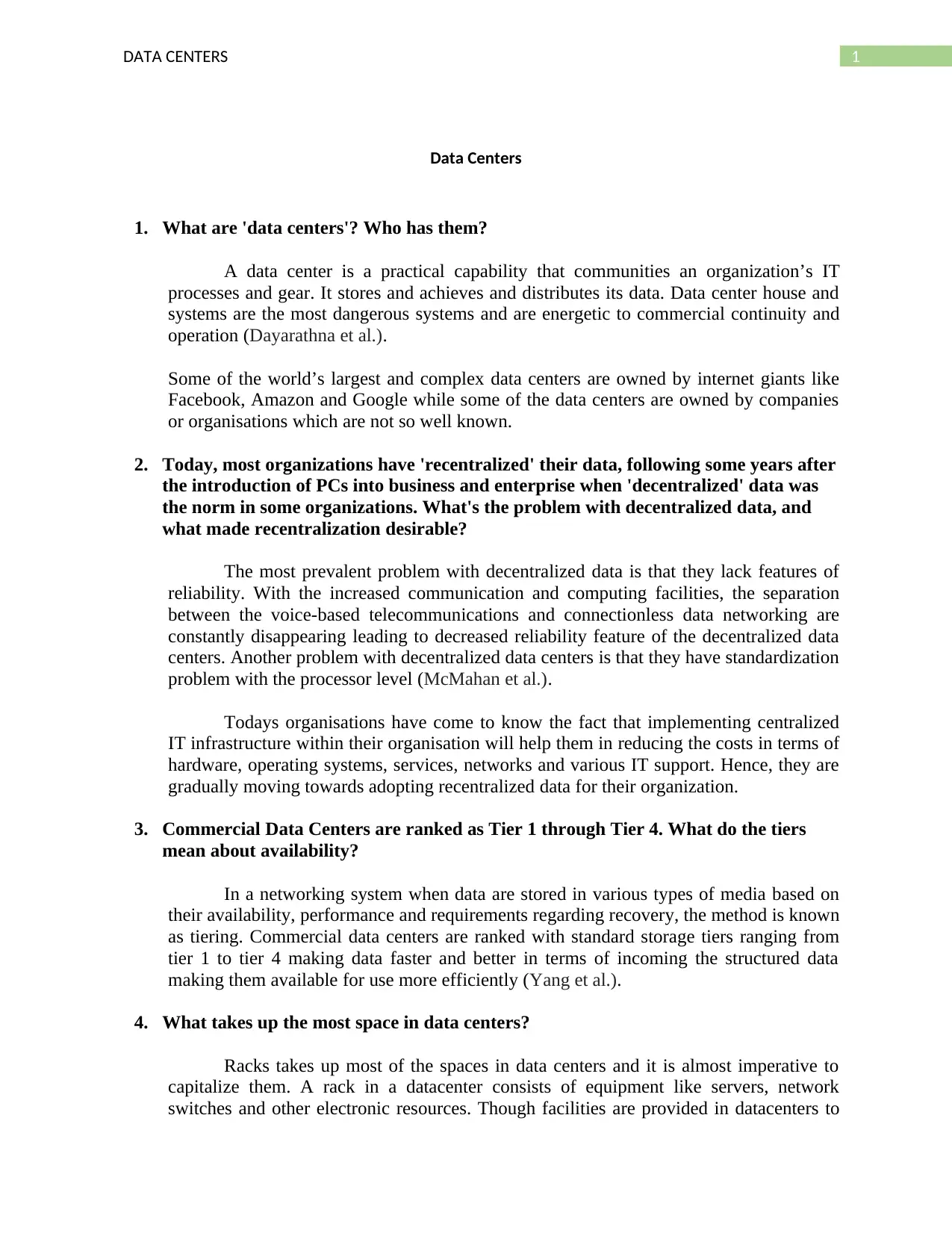
1DATA CENTERS
Data Centers
1. What are 'data centers'? Who has them?
A data center is a practical capability that communities an organization’s IT
processes and gear. It stores and achieves and distributes its data. Data center house and
systems are the most dangerous systems and are energetic to commercial continuity and
operation (Dayarathna et al.).
Some of the world’s largest and complex data centers are owned by internet giants like
Facebook, Amazon and Google while some of the data centers are owned by companies
or organisations which are not so well known.
2. Today, most organizations have 'recentralized' their data, following some years after
the introduction of PCs into business and enterprise when 'decentralized' data was
the norm in some organizations. What's the problem with decentralized data, and
what made recentralization desirable?
The most prevalent problem with decentralized data is that they lack features of
reliability. With the increased communication and computing facilities, the separation
between the voice-based telecommunications and connectionless data networking are
constantly disappearing leading to decreased reliability feature of the decentralized data
centers. Another problem with decentralized data centers is that they have standardization
problem with the processor level (McMahan et al.).
Todays organisations have come to know the fact that implementing centralized
IT infrastructure within their organisation will help them in reducing the costs in terms of
hardware, operating systems, services, networks and various IT support. Hence, they are
gradually moving towards adopting recentralized data for their organization.
3. Commercial Data Centers are ranked as Tier 1 through Tier 4. What do the tiers
mean about availability?
In a networking system when data are stored in various types of media based on
their availability, performance and requirements regarding recovery, the method is known
as tiering. Commercial data centers are ranked with standard storage tiers ranging from
tier 1 to tier 4 making data faster and better in terms of incoming the structured data
making them available for use more efficiently (Yang et al.).
4. What takes up the most space in data centers?
Racks takes up most of the spaces in data centers and it is almost imperative to
capitalize them. A rack in a datacenter consists of equipment like servers, network
switches and other electronic resources. Though facilities are provided in datacenters to
Data Centers
1. What are 'data centers'? Who has them?
A data center is a practical capability that communities an organization’s IT
processes and gear. It stores and achieves and distributes its data. Data center house and
systems are the most dangerous systems and are energetic to commercial continuity and
operation (Dayarathna et al.).
Some of the world’s largest and complex data centers are owned by internet giants like
Facebook, Amazon and Google while some of the data centers are owned by companies
or organisations which are not so well known.
2. Today, most organizations have 'recentralized' their data, following some years after
the introduction of PCs into business and enterprise when 'decentralized' data was
the norm in some organizations. What's the problem with decentralized data, and
what made recentralization desirable?
The most prevalent problem with decentralized data is that they lack features of
reliability. With the increased communication and computing facilities, the separation
between the voice-based telecommunications and connectionless data networking are
constantly disappearing leading to decreased reliability feature of the decentralized data
centers. Another problem with decentralized data centers is that they have standardization
problem with the processor level (McMahan et al.).
Todays organisations have come to know the fact that implementing centralized
IT infrastructure within their organisation will help them in reducing the costs in terms of
hardware, operating systems, services, networks and various IT support. Hence, they are
gradually moving towards adopting recentralized data for their organization.
3. Commercial Data Centers are ranked as Tier 1 through Tier 4. What do the tiers
mean about availability?
In a networking system when data are stored in various types of media based on
their availability, performance and requirements regarding recovery, the method is known
as tiering. Commercial data centers are ranked with standard storage tiers ranging from
tier 1 to tier 4 making data faster and better in terms of incoming the structured data
making them available for use more efficiently (Yang et al.).
4. What takes up the most space in data centers?
Racks takes up most of the spaces in data centers and it is almost imperative to
capitalize them. A rack in a datacenter consists of equipment like servers, network
switches and other electronic resources. Though facilities are provided in datacenters to
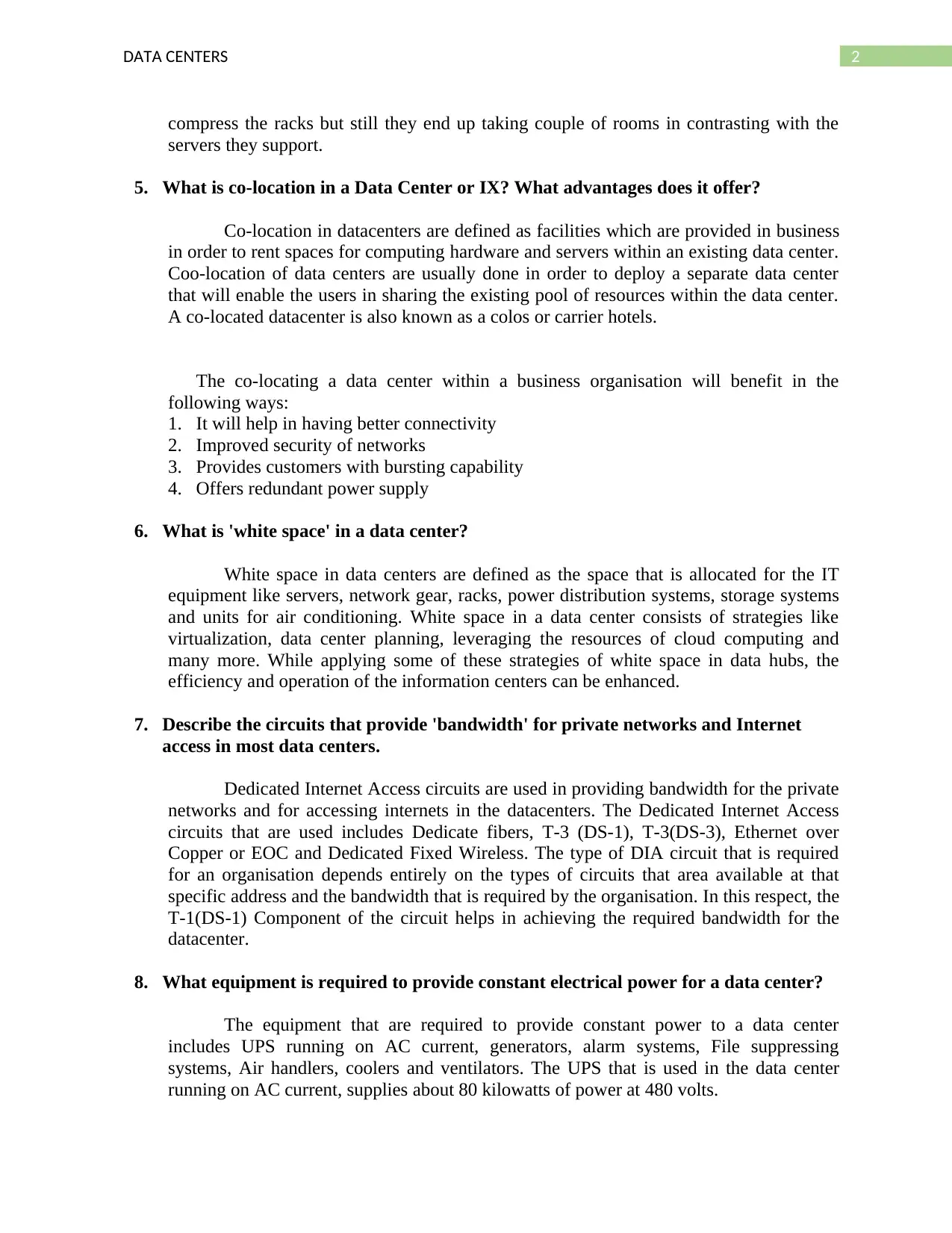
2DATA CENTERS
compress the racks but still they end up taking couple of rooms in contrasting with the
servers they support.
5. What is co-location in a Data Center or IX? What advantages does it offer?
Co-location in datacenters are defined as facilities which are provided in business
in order to rent spaces for computing hardware and servers within an existing data center.
Coo-location of data centers are usually done in order to deploy a separate data center
that will enable the users in sharing the existing pool of resources within the data center.
A co-located datacenter is also known as a colos or carrier hotels.
The co-locating a data center within a business organisation will benefit in the
following ways:
1. It will help in having better connectivity
2. Improved security of networks
3. Provides customers with bursting capability
4. Offers redundant power supply
6. What is 'white space' in a data center?
White space in data centers are defined as the space that is allocated for the IT
equipment like servers, network gear, racks, power distribution systems, storage systems
and units for air conditioning. White space in a data center consists of strategies like
virtualization, data center planning, leveraging the resources of cloud computing and
many more. While applying some of these strategies of white space in data hubs, the
efficiency and operation of the information centers can be enhanced.
7. Describe the circuits that provide 'bandwidth' for private networks and Internet
access in most data centers.
Dedicated Internet Access circuits are used in providing bandwidth for the private
networks and for accessing internets in the datacenters. The Dedicated Internet Access
circuits that are used includes Dedicate fibers, T-3 (DS-1), T-3(DS-3), Ethernet over
Copper or EOC and Dedicated Fixed Wireless. The type of DIA circuit that is required
for an organisation depends entirely on the types of circuits that area available at that
specific address and the bandwidth that is required by the organisation. In this respect, the
T-1(DS-1) Component of the circuit helps in achieving the required bandwidth for the
datacenter.
8. What equipment is required to provide constant electrical power for a data center?
The equipment that are required to provide constant power to a data center
includes UPS running on AC current, generators, alarm systems, File suppressing
systems, Air handlers, coolers and ventilators. The UPS that is used in the data center
running on AC current, supplies about 80 kilowatts of power at 480 volts.
compress the racks but still they end up taking couple of rooms in contrasting with the
servers they support.
5. What is co-location in a Data Center or IX? What advantages does it offer?
Co-location in datacenters are defined as facilities which are provided in business
in order to rent spaces for computing hardware and servers within an existing data center.
Coo-location of data centers are usually done in order to deploy a separate data center
that will enable the users in sharing the existing pool of resources within the data center.
A co-located datacenter is also known as a colos or carrier hotels.
The co-locating a data center within a business organisation will benefit in the
following ways:
1. It will help in having better connectivity
2. Improved security of networks
3. Provides customers with bursting capability
4. Offers redundant power supply
6. What is 'white space' in a data center?
White space in data centers are defined as the space that is allocated for the IT
equipment like servers, network gear, racks, power distribution systems, storage systems
and units for air conditioning. White space in a data center consists of strategies like
virtualization, data center planning, leveraging the resources of cloud computing and
many more. While applying some of these strategies of white space in data hubs, the
efficiency and operation of the information centers can be enhanced.
7. Describe the circuits that provide 'bandwidth' for private networks and Internet
access in most data centers.
Dedicated Internet Access circuits are used in providing bandwidth for the private
networks and for accessing internets in the datacenters. The Dedicated Internet Access
circuits that are used includes Dedicate fibers, T-3 (DS-1), T-3(DS-3), Ethernet over
Copper or EOC and Dedicated Fixed Wireless. The type of DIA circuit that is required
for an organisation depends entirely on the types of circuits that area available at that
specific address and the bandwidth that is required by the organisation. In this respect, the
T-1(DS-1) Component of the circuit helps in achieving the required bandwidth for the
datacenter.
8. What equipment is required to provide constant electrical power for a data center?
The equipment that are required to provide constant power to a data center
includes UPS running on AC current, generators, alarm systems, File suppressing
systems, Air handlers, coolers and ventilators. The UPS that is used in the data center
running on AC current, supplies about 80 kilowatts of power at 480 volts.
⊘ This is a preview!⊘
Do you want full access?
Subscribe today to unlock all pages.

Trusted by 1+ million students worldwide
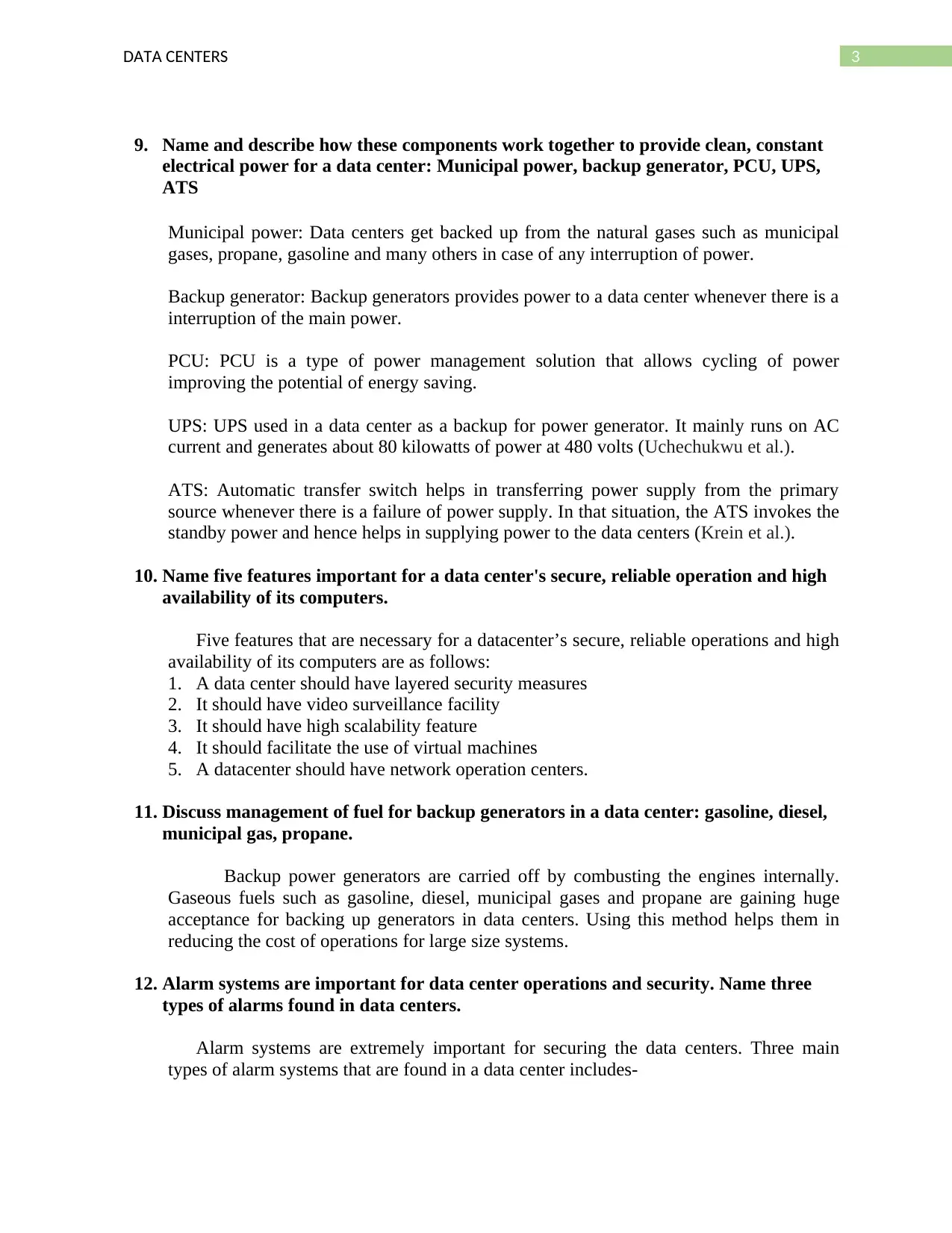
3DATA CENTERS
9. Name and describe how these components work together to provide clean, constant
electrical power for a data center: Municipal power, backup generator, PCU, UPS,
ATS
Municipal power: Data centers get backed up from the natural gases such as municipal
gases, propane, gasoline and many others in case of any interruption of power.
Backup generator: Backup generators provides power to a data center whenever there is a
interruption of the main power.
PCU: PCU is a type of power management solution that allows cycling of power
improving the potential of energy saving.
UPS: UPS used in a data center as a backup for power generator. It mainly runs on AC
current and generates about 80 kilowatts of power at 480 volts (Uchechukwu et al.).
ATS: Automatic transfer switch helps in transferring power supply from the primary
source whenever there is a failure of power supply. In that situation, the ATS invokes the
standby power and hence helps in supplying power to the data centers (Krein et al.).
10. Name five features important for a data center's secure, reliable operation and high
availability of its computers.
Five features that are necessary for a datacenter’s secure, reliable operations and high
availability of its computers are as follows:
1. A data center should have layered security measures
2. It should have video surveillance facility
3. It should have high scalability feature
4. It should facilitate the use of virtual machines
5. A datacenter should have network operation centers.
11. Discuss management of fuel for backup generators in a data center: gasoline, diesel,
municipal gas, propane.
Backup power generators are carried off by combusting the engines internally.
Gaseous fuels such as gasoline, diesel, municipal gases and propane are gaining huge
acceptance for backing up generators in data centers. Using this method helps them in
reducing the cost of operations for large size systems.
12. Alarm systems are important for data center operations and security. Name three
types of alarms found in data centers.
Alarm systems are extremely important for securing the data centers. Three main
types of alarm systems that are found in a data center includes-
9. Name and describe how these components work together to provide clean, constant
electrical power for a data center: Municipal power, backup generator, PCU, UPS,
ATS
Municipal power: Data centers get backed up from the natural gases such as municipal
gases, propane, gasoline and many others in case of any interruption of power.
Backup generator: Backup generators provides power to a data center whenever there is a
interruption of the main power.
PCU: PCU is a type of power management solution that allows cycling of power
improving the potential of energy saving.
UPS: UPS used in a data center as a backup for power generator. It mainly runs on AC
current and generates about 80 kilowatts of power at 480 volts (Uchechukwu et al.).
ATS: Automatic transfer switch helps in transferring power supply from the primary
source whenever there is a failure of power supply. In that situation, the ATS invokes the
standby power and hence helps in supplying power to the data centers (Krein et al.).
10. Name five features important for a data center's secure, reliable operation and high
availability of its computers.
Five features that are necessary for a datacenter’s secure, reliable operations and high
availability of its computers are as follows:
1. A data center should have layered security measures
2. It should have video surveillance facility
3. It should have high scalability feature
4. It should facilitate the use of virtual machines
5. A datacenter should have network operation centers.
11. Discuss management of fuel for backup generators in a data center: gasoline, diesel,
municipal gas, propane.
Backup power generators are carried off by combusting the engines internally.
Gaseous fuels such as gasoline, diesel, municipal gases and propane are gaining huge
acceptance for backing up generators in data centers. Using this method helps them in
reducing the cost of operations for large size systems.
12. Alarm systems are important for data center operations and security. Name three
types of alarms found in data centers.
Alarm systems are extremely important for securing the data centers. Three main
types of alarm systems that are found in a data center includes-
Paraphrase This Document
Need a fresh take? Get an instant paraphrase of this document with our AI Paraphraser
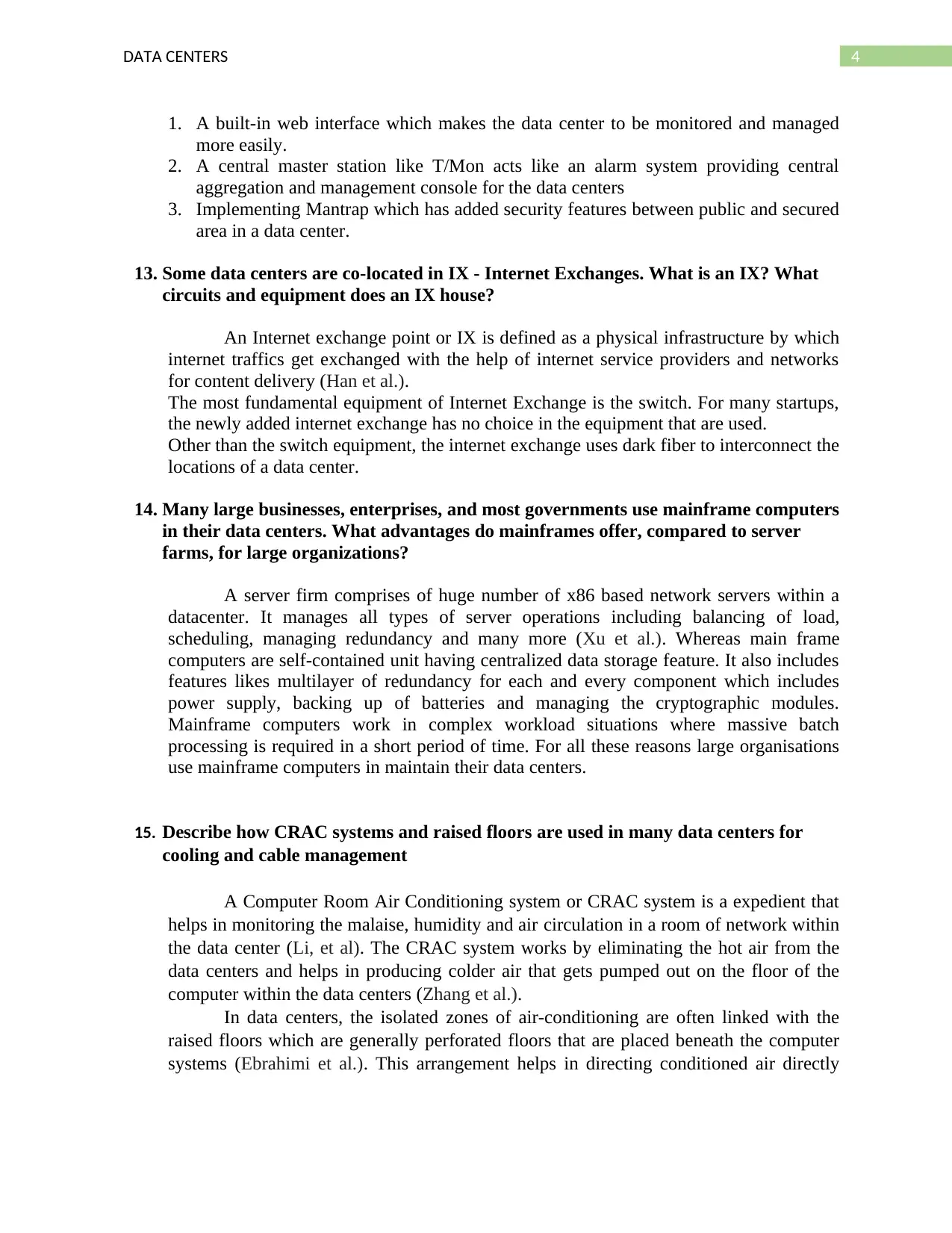
4DATA CENTERS
1. A built-in web interface which makes the data center to be monitored and managed
more easily.
2. A central master station like T/Mon acts like an alarm system providing central
aggregation and management console for the data centers
3. Implementing Mantrap which has added security features between public and secured
area in a data center.
13. Some data centers are co-located in IX - Internet Exchanges. What is an IX? What
circuits and equipment does an IX house?
An Internet exchange point or IX is defined as a physical infrastructure by which
internet traffics get exchanged with the help of internet service providers and networks
for content delivery (Han et al.).
The most fundamental equipment of Internet Exchange is the switch. For many startups,
the newly added internet exchange has no choice in the equipment that are used.
Other than the switch equipment, the internet exchange uses dark fiber to interconnect the
locations of a data center.
14. Many large businesses, enterprises, and most governments use mainframe computers
in their data centers. What advantages do mainframes offer, compared to server
farms, for large organizations?
A server firm comprises of huge number of x86 based network servers within a
datacenter. It manages all types of server operations including balancing of load,
scheduling, managing redundancy and many more (Xu et al.). Whereas main frame
computers are self-contained unit having centralized data storage feature. It also includes
features likes multilayer of redundancy for each and every component which includes
power supply, backing up of batteries and managing the cryptographic modules.
Mainframe computers work in complex workload situations where massive batch
processing is required in a short period of time. For all these reasons large organisations
use mainframe computers in maintain their data centers.
15. Describe how CRAC systems and raised floors are used in many data centers for
cooling and cable management
A Computer Room Air Conditioning system or CRAC system is a expedient that
helps in monitoring the malaise, humidity and air circulation in a room of network within
the data center (Li, et al). The CRAC system works by eliminating the hot air from the
data centers and helps in producing colder air that gets pumped out on the floor of the
computer within the data centers (Zhang et al.).
In data centers, the isolated zones of air-conditioning are often linked with the
raised floors which are generally perforated floors that are placed beneath the computer
systems (Ebrahimi et al.). This arrangement helps in directing conditioned air directly
1. A built-in web interface which makes the data center to be monitored and managed
more easily.
2. A central master station like T/Mon acts like an alarm system providing central
aggregation and management console for the data centers
3. Implementing Mantrap which has added security features between public and secured
area in a data center.
13. Some data centers are co-located in IX - Internet Exchanges. What is an IX? What
circuits and equipment does an IX house?
An Internet exchange point or IX is defined as a physical infrastructure by which
internet traffics get exchanged with the help of internet service providers and networks
for content delivery (Han et al.).
The most fundamental equipment of Internet Exchange is the switch. For many startups,
the newly added internet exchange has no choice in the equipment that are used.
Other than the switch equipment, the internet exchange uses dark fiber to interconnect the
locations of a data center.
14. Many large businesses, enterprises, and most governments use mainframe computers
in their data centers. What advantages do mainframes offer, compared to server
farms, for large organizations?
A server firm comprises of huge number of x86 based network servers within a
datacenter. It manages all types of server operations including balancing of load,
scheduling, managing redundancy and many more (Xu et al.). Whereas main frame
computers are self-contained unit having centralized data storage feature. It also includes
features likes multilayer of redundancy for each and every component which includes
power supply, backing up of batteries and managing the cryptographic modules.
Mainframe computers work in complex workload situations where massive batch
processing is required in a short period of time. For all these reasons large organisations
use mainframe computers in maintain their data centers.
15. Describe how CRAC systems and raised floors are used in many data centers for
cooling and cable management
A Computer Room Air Conditioning system or CRAC system is a expedient that
helps in monitoring the malaise, humidity and air circulation in a room of network within
the data center (Li, et al). The CRAC system works by eliminating the hot air from the
data centers and helps in producing colder air that gets pumped out on the floor of the
computer within the data centers (Zhang et al.).
In data centers, the isolated zones of air-conditioning are often linked with the
raised floors which are generally perforated floors that are placed beneath the computer
systems (Ebrahimi et al.). This arrangement helps in directing conditioned air directly

5DATA CENTERS
within the data center. The whole process helps in drawing cool air from underneath the
systems and keeps the room exhausted.
within the data center. The whole process helps in drawing cool air from underneath the
systems and keeps the room exhausted.
⊘ This is a preview!⊘
Do you want full access?
Subscribe today to unlock all pages.

Trusted by 1+ million students worldwide
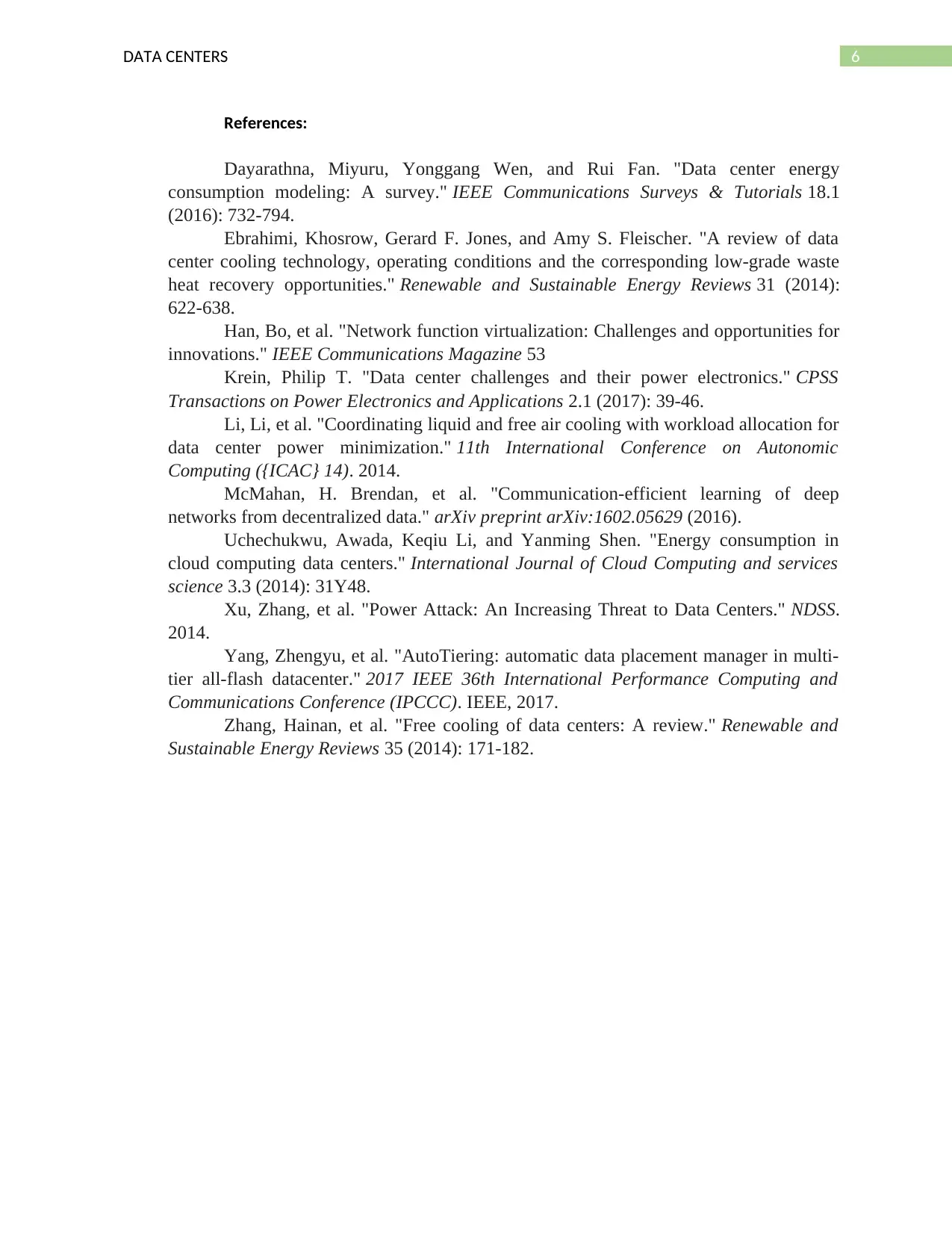
6DATA CENTERS
References:
Dayarathna, Miyuru, Yonggang Wen, and Rui Fan. "Data center energy
consumption modeling: A survey." IEEE Communications Surveys & Tutorials 18.1
(2016): 732-794.
Ebrahimi, Khosrow, Gerard F. Jones, and Amy S. Fleischer. "A review of data
center cooling technology, operating conditions and the corresponding low-grade waste
heat recovery opportunities." Renewable and Sustainable Energy Reviews 31 (2014):
622-638.
Han, Bo, et al. "Network function virtualization: Challenges and opportunities for
innovations." IEEE Communications Magazine 53
Krein, Philip T. "Data center challenges and their power electronics." CPSS
Transactions on Power Electronics and Applications 2.1 (2017): 39-46.
Li, Li, et al. "Coordinating liquid and free air cooling with workload allocation for
data center power minimization." 11th International Conference on Autonomic
Computing ({ICAC} 14). 2014.
McMahan, H. Brendan, et al. "Communication-efficient learning of deep
networks from decentralized data." arXiv preprint arXiv:1602.05629 (2016).
Uchechukwu, Awada, Keqiu Li, and Yanming Shen. "Energy consumption in
cloud computing data centers." International Journal of Cloud Computing and services
science 3.3 (2014): 31Y48.
Xu, Zhang, et al. "Power Attack: An Increasing Threat to Data Centers." NDSS.
2014.
Yang, Zhengyu, et al. "AutoTiering: automatic data placement manager in multi-
tier all-flash datacenter." 2017 IEEE 36th International Performance Computing and
Communications Conference (IPCCC). IEEE, 2017.
Zhang, Hainan, et al. "Free cooling of data centers: A review." Renewable and
Sustainable Energy Reviews 35 (2014): 171-182.
References:
Dayarathna, Miyuru, Yonggang Wen, and Rui Fan. "Data center energy
consumption modeling: A survey." IEEE Communications Surveys & Tutorials 18.1
(2016): 732-794.
Ebrahimi, Khosrow, Gerard F. Jones, and Amy S. Fleischer. "A review of data
center cooling technology, operating conditions and the corresponding low-grade waste
heat recovery opportunities." Renewable and Sustainable Energy Reviews 31 (2014):
622-638.
Han, Bo, et al. "Network function virtualization: Challenges and opportunities for
innovations." IEEE Communications Magazine 53
Krein, Philip T. "Data center challenges and their power electronics." CPSS
Transactions on Power Electronics and Applications 2.1 (2017): 39-46.
Li, Li, et al. "Coordinating liquid and free air cooling with workload allocation for
data center power minimization." 11th International Conference on Autonomic
Computing ({ICAC} 14). 2014.
McMahan, H. Brendan, et al. "Communication-efficient learning of deep
networks from decentralized data." arXiv preprint arXiv:1602.05629 (2016).
Uchechukwu, Awada, Keqiu Li, and Yanming Shen. "Energy consumption in
cloud computing data centers." International Journal of Cloud Computing and services
science 3.3 (2014): 31Y48.
Xu, Zhang, et al. "Power Attack: An Increasing Threat to Data Centers." NDSS.
2014.
Yang, Zhengyu, et al. "AutoTiering: automatic data placement manager in multi-
tier all-flash datacenter." 2017 IEEE 36th International Performance Computing and
Communications Conference (IPCCC). IEEE, 2017.
Zhang, Hainan, et al. "Free cooling of data centers: A review." Renewable and
Sustainable Energy Reviews 35 (2014): 171-182.
1 out of 7
Related Documents
Your All-in-One AI-Powered Toolkit for Academic Success.
+13062052269
info@desklib.com
Available 24*7 on WhatsApp / Email
![[object Object]](/_next/static/media/star-bottom.7253800d.svg)
Unlock your academic potential
Copyright © 2020–2025 A2Z Services. All Rights Reserved. Developed and managed by ZUCOL.





